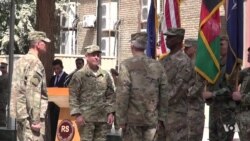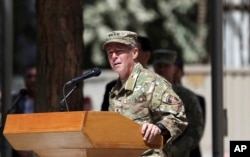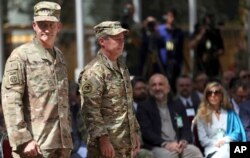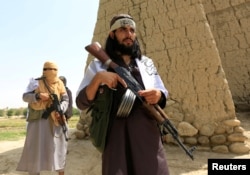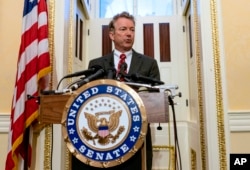The 17th commander to lead the NATO and United States forces in Afghanistan in what has become America’s longest war took charge in a change of command ceremony in Kabul Sunday morning.
General Austin Scott Miller of the U.S. Army is taking over at a time when Afghanistan is experiencing a combination of hope, apprehension, and uncertainty.
A first-ever cease-fire between the warring factions during the Muslim holy festival Eid-al-Fitr in June, followed by direct contacts between Taliban and U.S. officials in Qatar, raised hopes that a start of negotiations with the Taliban for a political settlement of the 17 year old conflict could be imminent.
Those hopes were dashed last month when the Taliban failed to reciprocate President Ashraf Ghani’s offer for a second cease-fire during the holy festival of Eid-al-Adha.
General John Nicholson, the outgoing commander, indicated that the Taliban decision may have been influenced by their foreign backers.
“I believe that some of the Taliban want peace also, but they are being encouraged to keep fighting,” he said while addressing the ceremony. He appealed to the Taliban’s sense of nationalism.
“To the Taliban I say, you don’t need to keep killing your fellow Afghans. You don’t need to keep killing your fellow Muslims. . . . Whose voice is more important? The outsiders who are encouraging you to fight? Or the voice of your own people who are encouraging you to peace.”
U.S. officials as well as Afghans have long accused Pakistan of providing safe havens to the leadership of the Afghan Taliban — a charge Islamabad denies.
During June’s cease-fire, Taliban fighters headed to the cities and hung out with Afghan civilians. Some of them even went to the extent of offering Eid prayers and taking selfies with their battlefield enemies in the Afghan security forces. Many of them admitted to journalists that they were tired of fighting but also reaffirmed their loyalty to their Amir in the Afghan Taliban, whom they consider their holy leader.
The brief respite from violence did not last long. The Taliban attacks after the cease fire were just as bloody as before. One of them, the attack on Ghazni, a provincial capital close to Kabul, was so organized and bloody that it rattled Afghan forces and led to the forced resignation of the National Security Adviser Hanif Atmar.
It took Afghan forces backed by U.S. airpower several days to clear the city of Taliban fighters.
Still, the emphasis in Washington and in Kabul continues to be to push the Taliban to negotiate. General Miller acknowledged it in his speech.
“We know the military component is only one part of this conditions-based strategy. It’s necessary in order to create space for political progress,” he said.
However, if these efforts fail to bear fruit soon, some in Washington fear President Donald Trump, who said while announcing his South Asia policy last year that he was going against his instinct to pull out, would lose patience.
According to The Washington Post, President Trump told Senator Rand Paul of Kentucky that he wanted to pull out of Afghanistan. One of the reasons for his impatience is the high price tag. The U.S. Congress has year marked more than $46 billion for next year’s military operations. In the last 17 years, the U.S. has spent more than $1 trillion in the country, according to Congressional Research Service.
General Miller, like commanders before him, is in favor of a continued U.S. military presence in Afghanistan, at least till the country stabilized.
“There are groups in Afghanistan that want nothing more than to harm others. These groups thrive in ungoverned spaces. . . . We must maintain pressure on them. We must ensure that terrorists can never use Afghanistan as a safe haven to threaten the world,” he said, re-iterating his predecessors.
Afghanistan is not a new territory for Miller, who served here as the head of Special Operations a few years back. He was also among the American soldiers to be deployed to the country when the war started in 2001.
In his last job he served as the head of Joint Special Operations Command, which oversees some of the U.S. military’s elite units like SEAL Team 6 — the unit involved in the highly risky operation that killed Osama Bin Laden deep inside Pakistan.
The strength of U.S. and NATO forces he now leads is around 23,000, down from a one-time high of close to 150,000 troops but slightly more than the almost 9,000 forces operating in the country by the time President Barack Obama left office. About half, or around 14,000, of these are American troops.




